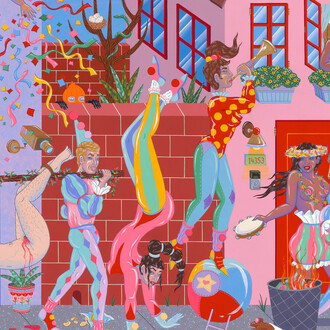François Ghebaly is proud to present Machina, Jaime Muñoz’s first solo exhibition with the gallery at its New York location.
In April of 2023, to the disquietude of many city-dwellers, the NYPD announced its reintroduction of American robotics manufacturer Boston Dynamics’ “canine” robot to the fleet. The four-legged robot, with its retractable proboscis-like armature, uncanny gait, and unmistakable “A-08” designation, features centrally in Los Angeles-based artist Jaime Muñoz’s work Diagram drawing #7 (2023), part of his newest exhibition entitled Machina. Drawn in inky grisaille, and against a background depicting the gauntlet of an armored figure, the robot and its constituent image appear at once hyper-mechanical and primal. Muñoz adapts the gauntlet from J.R.R. Tolkien’s fictional “Nazgûl,” a cadre of powerful knights who were corrupted by the mind-bending influence of “the Ring.” In this light, Muñoz’s robot, like many others in Machina, becomes a steely foreboding of power, surveillance, and the futures of technologization.
Do not let the sumptuous velvet flocking and dreamlike, sunset palettes of Muñoz’s larger paintings fool you––the printmaker, draftsman, and painter has long aimed his practice’s iconographic focus at the nexus of mechanization and American labor. Muñoz’s images operate in a patchwork fashion, drawing throughlines between the unmistakable visual vocabulary of Southern California life (think vibrant ombrés, polychrome signage, and West Coast automobilia) and the iconographies of popular culture and labor history. The latter ranges in Muñoz’s work from antiquity and the American industrial revolution, to pickup trucks and other ubiquitous tools of modern industry, to 20th century labor revolutions and parables in contemporary fantasy and science fiction. For Machina, Muñoz examines a new, daunting chapter in this distinctly American history: the realm of hyper-surveillance, advanced robotics, and artificial intelligence.
Between touchstones like James Cameron’s Terminator franchise, or the 1980’s union takeover of Mexican soda brand “Boing,” Muñoz finds a key subject in Karel Čapek’s 1920 Czech-language play R.U.R., or “Rossumovi Univerzální Roboti” (Rossum’s Universal Robots). The play follows a class of laborer-robots whose artificial intelligence advances such that they revolt against their human masters, a conspicuous metaphor for the awakened class consciousness and revolution of the proletariat. In the essay “Why Do Robots Rebel?: The Labor History,” Tobias Higbie likens Čapek’s robot to concepts such as Donna Haraway’s ‘cyborg’:
Čapek offered the Robots, their rebellion, and happy ending as a way to think through the modern dilemma. As its image shifted from nearly human to mostly machine, the Robot lost a lot of its interpretive potential. By recovering [Čapek’s] earlier, murkier meaning of the Robot we can see the centrality of working people, real and imagined, to the cultural life of modernity.
For Muñoz, too, his robots become complicated, “murky” figures. At different times they’re the fearsome antagonists of the state, the mechanized interlocutors of industry, or shrewd metaphors for the laborer himself and the material realities of organizing. In this vein, Muñoz’s work acts as a sort of equalizer, between the domains of high-speculative fiction and unflinching social realism, all the while operating in the hazy in-between space of so-called “real life.” What will ultimately occur there is perhaps the exhibition’s tallest gesture: in When Do Robots Rebel? (2023), Muñoz finely prints the titular phrase along the vein-like contours of the Terminator’s hydraulic tubing. Whether human or machine, it’s an imperative latent in each and every one of Machina’s brave new worlds.
Jaime Muñoz (b. 1987, Los Angeles, CA) lives and works in Pomona, CA and received his BFA from the University of California Los Angeles in 2016. Recent solo exhibitions include François Ghebaly, New York (2023); and The Pit, Los Angeles (2022). His work was included in group presentations at the Long Beach Museum of Art, Long Beach, CA (2022); Nerman Museum of Contemporary Art, Overland Park, KS (2021); Southampton Arts Center, Southampton, NY (2021); Jeffrey Deitch, Los Angeles (2021, 2019); The Pit, Los Angeles (2021, 2019); Maki Gallery, Tokyo, Japan (2020); Riverside Art Museum, Riverside, CA (2018); MAK Center for the Arts, Los Angeles (2017) and the Austrian Museum of Applied Arts, Vienna, Austria (2017). Machina is Muñoz’s first solo exhibition with the gallery.
















